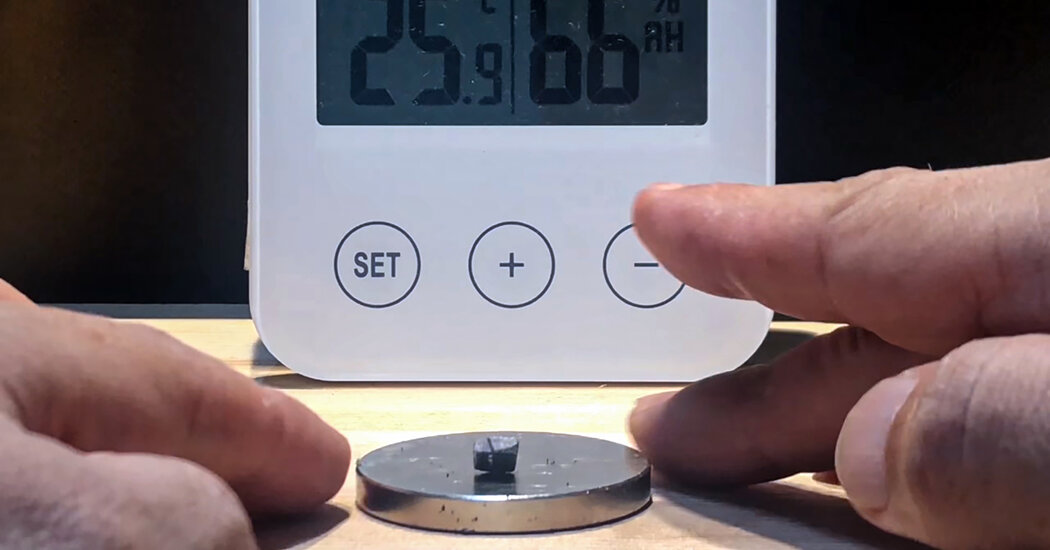When Sinéad Griffin of Lawrence Berkeley National Laboratory in California had some new findings to share about a seemingly magical material that has made users of Twitter go gaga, she did not have to do much to gain a lot of attention.
The unusual material, named LK-99, has been presented to the world as a superconductor that would carry electricity at room temperatures with zero resistance.
On Twitter — or X, as Elon Musk has renamed it — “LK-99” has been a trending topic in recent days, and enthusiasts have hailed what they believe to be a long-sought holy grail of physics, one that would transform everyday life with new technologies to solve climate change and make levitating trains commonplace.
On Monday evening, Dr. Griffin let the social media world know of her findings in a short post that contained only a link to her preliminary paper and an animated GIF of President Barack Obama dropping a microphone at the White House Correspondents Dinner in 2016.
The response was rhapsodic. The mic drop was interpreted by some X users as confirmation that the holy grail had been found.
Dr. Griffin thus provided another twist in a roller coaster of excitement and deflation that has enthralled LK-99 fans for more than a week.
The saga started when a team of South Korean scientists, most working for a tiny start-up company named Quantum Energy Research Center in Seoul, posted two reports that described their technique for making LK-99 and the measurements that they said showed the material’s superconducting prowess. (The name of the material comes from the initials of the surnames of two of the scientists — Sukbae Lee and Ji-Hoon Kim — and the year 1999, when they say they first synthesized LK-99.)
Most strikingly, they provided a video showing a small sample partially levitating over a magnet. The levitation, the scientists said, demonstrated the Meissner effect, which ensures zero magnetic field inside a superconductor.
Alex Kaplan, who had majored in physics at Princeton University, found out about LK-99 on Hacker News, a news aggregation website.
“I was just shocked,” Mr. Kaplan said in an interview. “My jaw dropped to the floor, and I started calling every friend that I knew in physics.”
That night, he shared his excitement on Twitter.
With that tweet, which has received more than 132,000 likes, Mr. Kaplan joined a group of LK-99 fans who propelled excitement on social media over the past week. Most of the enthusiasts are not experts, however. Mr. Kaplan, for example, works as the head of coffee product at Cometeer, a company that sells flash-frozen coffee concentrate.
The scientists who study superconductivity and solid state physics have been quieter. They appreciate the curiosity — their work rarely draws a frenzy of public glee — but they are puzzled as to why this particular room-temperature superconductor claim took off wildly while many earlier claims that did not prove out came and went without fanfare.
“It’s great having public interest in solid state physics research,” Dr. Griffin said, “with due caution of it being explained correctly and with the caveats I think that are needed for some of this discussion. But I think it’s fun.”
The skepticism remains, because the data provided by the Korean scientists thus far falls short of being convincing, many experts say.
“It is too soon to conclude anything about superconductivity,” said Sankar Das Sarma, director of the Condensed Matter Theory Center at the University of Maryland. “That data is extremely suggestive, but it is by no means compelling.”
Dr. Das Sarma has posted commentary on the center’s Twitter account. He pointed out, for instance, that at the temperature that Korean scientists claim LK-99 turns into a superconductor, the electrical resistance drops, but not to zero. Indeed, the resistance of the material, made of the mineral apatite with some of the lead atoms replaced by copper, is about 100 times higher than pure copper and other good conducting metals.
The levitation video is also not definitive, because non-superconducting materials including graphite can also partially float in the same way.
Last weekend, Mr. Kaplan, who had kicked off much of the initial excitement, posted an image of a Magic 8 ball that read, “It’s probably over.” Then he saw Dr. Griffin’s paper.
In an interview, Dr. Griffin said her paper, titled “Origin of correlated isolated flat bands in copper-substituted lead phosphate apatite,” did not confirm the hype.
“I’m not describing superconductivity in these calculations, for sure,” she said. Rather, her computer simulations show that the substitution of copper in the apatite did result in an unusual rearrangement of the atoms. The volume of the mineral’s crystal structure actually shrank slightly. That in turn appeared to shift the electronic structure to one that could be conducive to superconductivity.
The electronic features, known as “flat bands,” appear similar to what was observed in high-temperature superconductors, a class of materials discovered in the 1980s. (The name — high-temperature superconductors — is somewhat misleading. They work at temperatures considerably warmer than had been observed previously, but still colder than any naturally occurring place on Earth.)
The features could facilitate strong interactions between a lot of electrons, which could give rise to superconductivity — but not always.
Dr. Griffin concedes that the electronic structure calculations are less definitive than her findings about the shrinkage of the crystal because of the vast number of electrons involved. “There are inherently lots of approximations that you have to make in doing this,” she said. “It’s not a definitive calculation of what you measure in experiment.”
A group of Chinese scientists posted a paper describing similar calculations that found a similar electronic structure.
“I truly don’t get the excitement about her preprint,” said Douglas Natelson, a professor of physics at Rice University in Houston. “That’s not to say that it’s wrong, just that theorists and computational materials folks very often produce preprints based on the latest claimed material of interest. There’s nothing exceptional in that.”
On Wednesday, Dr. Griffin followed up with a long thread of tweets deflating the optimistic interpretations of the mic drop GIF.
The cycle of excitement and deflation repeated later in the day when scientists at Southeast University in Nanjing, China, reported that they had synthesized LK-99 and measured zero resistance in one of the samples.
However, the reported zero resistance occurred when the sample was cooled to minus-260 degrees Fahrenheit, not room temperatures, and it was a gradual diminishing of electrical resistance, not the sharp drop that would be expected of a superconductor. The data also showed a resistance dip at higher temperatures, which the Southeast University scientists attributed to impurities or an instrumental glitch.
Dr. Das Sarma was again unimpressed.
Like the original LK-99 papers, “Southeast also has no transition, just instrumental artifacts,” he wrote in a tweet. “What is the goal here? No one can fool nature.”
Dr. Das Sarma said he knew that the research groups of several prominent physicists were working to synthesize the material and make measurements to determine whether LK-99 is indeed a superconductor.
“A claim this huge has to be scrutinized very, very carefully,” Dr. Das Sarma said. “And has to be duplicated by independent groups in as many ways as possible before we declare victory.”
He added, “I believe this can happen. But that does not mean this has happened.”
Kenneth Chang has been at The Times since 2000, writing about physics, geology, chemistry, and the planets. Before becoming a science writer, he was a graduate student whose research involved the control of chaos. More about Kenneth Chang
Source: Read Full Article


